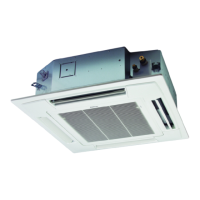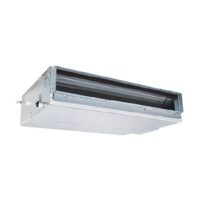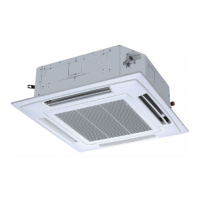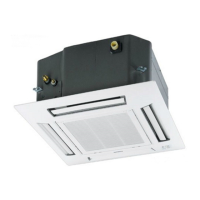179
Precautions for Insulation Installation
Maximum temperature limit of gas or liquid piping exceeds 120 °C
• In high humidity environment, reinforce the insulation material for the refrigerant piping. Failure to do so may
result in condensation on the surface of the insulation material.
• Use materials with good heat-resistant properties as the heat insulator for the pipes. Ensure to insulate both
the gas side and liquid side pipes.
If the pipes are not adequately insulated, condensation and water leakages may occur.
• Ensure that the current insulation covers the pipes up to the unit’s connecting part.
If the piping is exposed, it may cause condensation or burn (when touch the pipe).
Precautions for flare nut Installation
• Dimensions when adding flare nuts and the tightening torque
Piping size Tightening torque Flare section dimensions A Flare configuration
ø 6.35
14.2N•m ~ 17.2N•m
(1.4kgf•m ~ 1.7kgf•m)
8.7 ~ 9.1
ø 9.52
32.7N•m ~ 39.9N•m
(3.3kgf•m ~ 4.0kgf•m)
12.8 ~ 13.2
ø 12.7
49.5N•m ~ 60.3N•m
(5.0kgf•m ~ 6.0kgf•m)
16.2 ~ 16.6
ø 15.88
68.0N•m ~ 75.5N•m
(6.8kgf•m ~ 7.6kgf•m)
19.3 ~ 19.7
After piping connection has completed, ensure there is no gas leakage.
• When tightening the flare nut, coat the flares (inner surface only) with
refrigerant oil on the flares
Firstly, screw in 3-4 turns by hand.
Ensure not to get oil on the screw part.
Refrigerant oil used is ether-based.
• Once the piping connections are completed, perform leakage inspection
using nitrogen gas.
Brazing work
• Always blow nitrogen gas through the pipe during brazing work.
During brazing work, it is required to clean the inside of the pipe with nitrogen gas to prevent oxide scale
forming on the inner surface of the pipe. This is called nitrogen displacement which is an extremely important
step during refrigerant piping installation.
(Do not use an antioxidant)
<Procedure method>
11.14.6 VACUUM PURGING
Use nitrogen gas for the leak tightness test. Using flammable gas can cause an explosion.
• Once the piping connections are completed,
perform leakage inspection using nitrogen gas
(leak tightness test) using the 3-way valve for the
outdoor unit and then close it.
(Test the pressure with 4.15 MPa)
• Ensure to use a vacuum pump (with a back-flow
prevention device) for inside the refrigerant
system.
• Vacuuming process will take place after the reak
test.
Outdoor unit
3-way
valve
Indoor unit
Pressure
meter
Nitrogen Refrigerant
meter
Vacuum
pump

